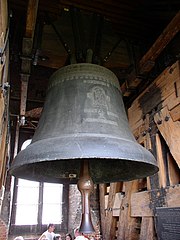Sigismund Bell
| Royal Sigismund Bell | |
| Królewski Dzwon Zygmunt | |
| Tower bell | |
|
The Sigismund Bell
|
|
| Named for: King Sigismund I of Poland | |
| Country | Poland |
|---|---|
| City | Kraków |
| Building | Sigismund Tower |
| Location | Wawel Cathedral |
| - coordinates | 50°03′17″N 19°56′09″E / 50.05472°N 19.93583°ECoordinates: 50°03′17″N 19°56′09″E / 50.05472°N 19.93583°E |
| Diameter | 2.42 m (8 ft) |
| - yoke length | 3.08 m (10 ft) |
| Total height (incl. yoke) | 4.60 m (15 ft) |
| - body and crown | 2.41 m (8 ft) |
| - clapper length | 2.20 m (7 ft) |
| Volume | 1.2 m3 (42 cu ft) |
| Weight | 12,600 kg (27,778 lb) |
| - body | 9,650 kg (21,275 lb) |
| - clapper (with belt) | 365 kg (805 lb) |
| - yoke | 2,160 kg (4,762 lb) |
| - other parts | 425 kg (937 lb) |
| Caster | Hans Behem |
| Materials | Bronze (80% copper, 20% tin), iron (clapper), leather (clapper belt), oak (yoke) |
| Cast | 1520 |
| - installed | 13 July 1521 |
| - new clapper | 14 April 2001 |
| Commissioned by | King Sigismund I of Poland |
| Musical note | F♯ |
| Earshot | 30 km (19 mi) |
| Number of ringers | 12 |
| Sources: | |
The Royal Sigismund Bell (Polish: Królewski Dzwon Zygmunt or Dzwon Zygmunta) is the largest of the five bells hanging in the Sigismund Tower of the Wawel Cathedral in the Polish city of Kraków. It was cast in 1520 by Hans Behem and named after King Sigismund I of Poland, who commissioned it. The bell weighs almost 13 tonnes (28 thousand pounds) and requires 12 bell-ringers to swing it. It tolls on special occasions, mostly religious and national holidays, and is regarded as one of Poland's national symbols.
The body of the Sigismund Bell is cast in bronze and weighs 9,650 kg. Its diameter at the lip is 242 cm and its height is 241 cm. The wall of the body is from 7 to 21 cm thick. The crown of the bell is attached to a yoke made of oak wood and measuring 308 cm in length and 219 cm in height. Within the bell, suspended on a leather belt of up to 12 layers, attached to an iron supporting structure, is a Gothic clapper, weighing – together with the belt – 365 kg.
The body of the bell is decorated with inscriptions and images. Around the upper part of the waist runs a majuscule Renaissance Latin inscription indicating the bell's donor and dedicating it to God:
Deo Opt Max ac Virgini Deiparae sanctisque patronis suis divus Sigismundus Poloniae Rex
campanam hanc dignam animi operumque ac gestorum suorum magnitudine fieri fecit anno salutis
MDXX
The inscription translates as follows: "To the greatest and best God, and to the Virgin Mother of God, the illustrious King Sigismund of Poland had this bell cast to be worthy of the greatness of his mind and deeds in the year of salvation 1520." Below the inscription there are two portal-shaped plaques with images of saints. The one below the date "MDXX" (1520 in Roman numerals) is a likeness of Saint Sigismund,patron saint of the bell and of the king who commissioned it, dressed in royal vestments and insignia as a king of Burgundy.
...
Wikipedia

